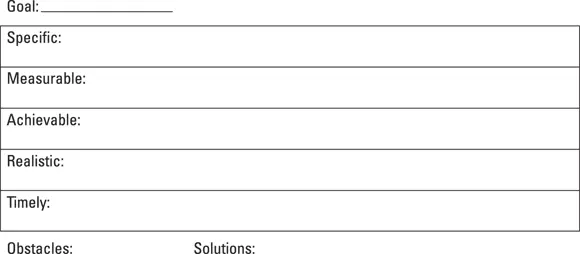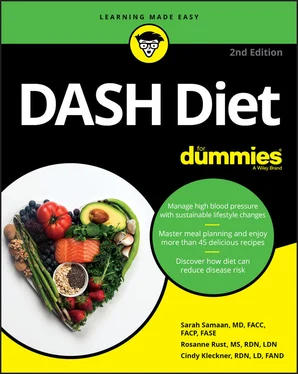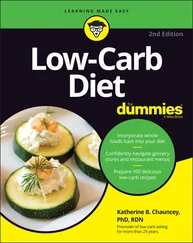You can do the same for exercise, but you can also measure the activity itself (not just completing it, but the intensity or duration of it). If you begin a walking routine and it takes you 60 minutes to walk 3 miles, you may consider setting a goal to improve your speed. Measure this goal by using a watch and timing your walks, and then you can easily see your progress.
You can also take some baseline measurements right before you make changes in diet and lifestyle and then come back and measure them in three months (fruit/vegetable servings, weight when starting DASH, waist measurement, and so on).
 The scale is an objective measurement tool, but don’t get overly obsessed with it, especially if it isn’t budging or your weight loss is slow going. Body weight is one aspect of health, but there are others. Meeting your weekly exercise goals and goals to improve the quality of your daily diet is wonderful progress in the right direction. Sometimes getting overly concerned with the number on the scale can be negative feedback that sends you off track.
The scale is an objective measurement tool, but don’t get overly obsessed with it, especially if it isn’t budging or your weight loss is slow going. Body weight is one aspect of health, but there are others. Meeting your weekly exercise goals and goals to improve the quality of your daily diet is wonderful progress in the right direction. Sometimes getting overly concerned with the number on the scale can be negative feedback that sends you off track.
Consider using your smartphone or a fitness tracker (like a Fitbit) to track your sitting and standing goals. Let’s face it, we sit too much. Simply working toward more movement and standing in your day-to-day life helps keep your metabolism revving. You can set goals into your program and continue to track and improve.
Also consider how attainable your goal is. Losing 30 pounds by next month isn’t attainable, but breaking that goal into smaller, doable goals — such as “I will lose 2 pounds over the next week” — feels a lot more attainable. Setting attainable goals is all about being realistic and not setting yourself up to fail.
Setting realistic goals helps you move forward and stay on track. Realistic goals aren’t self-defeating; they’re doable. Try to be honest with yourself. If you’ve never eaten fruits and vegetables on a daily basis, then don’t set yourself up for failure by setting the unrealistic goal that starting tomorrow, you’re going to eat 8 servings of fruits and vegetables a day. It probably won’t happen. Start small, and then build on that. A small step forward is still a step in the right direction.
Goals should be timely too. While you want them to be realistic, it’s still helpful to look down the road a bit and set the bigger goals you want to achieve. For instance, maybe you started jogging a mile a day. You may set a goal to add a quarter mile to that every week, to be able to run 3 miles in 8 weeks, and to enter a 5K race in 12 weeks. Placing goals on an incremental timeline helps you achieve them more successfully.
 Recording an end date can keep goals timely and help make sure they happen. Whether you set goals for behaviors that need to occur daily, weekly, or over a period of months, putting the timeline in place helps you stay on track:
Recording an end date can keep goals timely and help make sure they happen. Whether you set goals for behaviors that need to occur daily, weekly, or over a period of months, putting the timeline in place helps you stay on track:
I will plan my meals and snacks.
I will weigh myself every Tuesday to track my weight-loss progress.
I will begin eating two extra servings of fruit per day.
I will cook two new vegetables this week.
Having a visual goal sheet in writing can help you stick to your plan and be accountable. Figure 4-1 provides an example of how you may record your goals.

© John Wiley & Sons, Inc.
FIGURE 4-1:Sample goal worksheet.
 Setting too many goals all at once can be overwhelming and unproductive. Try to work on two to three goals at a time. After a goal becomes an everyday habit, check it off and move on to a new goal.
Setting too many goals all at once can be overwhelming and unproductive. Try to work on two to three goals at a time. After a goal becomes an everyday habit, check it off and move on to a new goal.
HOW MANY CALORIES DO YOU NEED?
Several clinical formulas can determine how many calories a person needs, but you can use a phone app or this general rule of thumb to give you a good estimate: Multiplying your body weight in pounds by 10 or 15 (use 10 if you’re older or more sedentary and 15 if you’re regularly active) gives you the approximate number of calories you burn daily. If you’re overweight or obese, you need to reduce this amount to lose weight. The following table breaks down the daily calorie needs for women:
| Age (Years) |
Calories (Sedentary) |
Calories (Moderately Active) |
Calories (Active) |
| 19–30 |
2,000 |
2,000–2,200 |
2,400 |
| 31–50 |
1,800 |
2,000 |
2,200 |
| 51+ |
1,600 |
1,800 |
2,000–2,200 |
Here are the daily calorie needs for men:
| Age (Years) |
Calories (Sedentary) |
Calories (Moderately Active) |
Calories (Active) |
| 19–30 |
2,400 |
2,600–2,800 |
3,000 |
| 31–50 |
2,200 |
2,400–2,600 |
2,800–3,000 |
| 51+ |
2,000 |
2,200–2,400 |
2,400–2,800 |
Remember: If you need to lose weight, you have to create a calorie deficit by either reducing your intake of calories or burning more calories through exercise — or, ideally, both. And it’s not just about calories. The balance of nutrients is important, too. Including enough healthy fat and protein, as well as plenty of fiber, in your diet helps with nutrition and satiety, so make smart choices.
Keeping a record of your food intake and exercise routine can help you measure your success. Writing these things down helps you organize your goals, stay on track, and ultimately lower your blood pressure.
For instance, say you set a goal to add more low-fat dairy foods to your diet. Ask yourself: “How many more servings of dairy am I consuming every day now?” Perhaps you’ve also set some goals to increase physical activity: “Have I accomplished my goal to exercise for an hour three days a week?” Keep in mind that your goals are specific to you and they change over time.
 It’s a good idea to keep a food and exercise record every day for the first week or two after you begin the DASH lifestyle. After the first couple of weeks, you can just check in with yourself two or three days a week and record those days. The purpose of tracking your progress is to help you see what’s missing in your diet and help you focus on specific goals. You’ll be surprised how much it helps you focus and stay on track.
It’s a good idea to keep a food and exercise record every day for the first week or two after you begin the DASH lifestyle. After the first couple of weeks, you can just check in with yourself two or three days a week and record those days. The purpose of tracking your progress is to help you see what’s missing in your diet and help you focus on specific goals. You’ll be surprised how much it helps you focus and stay on track.
After a goal becomes habit, you can move on to the next goal. Some people find setting up a reward system motivating. Perhaps one of your dietary goals is to replace the candy bar you eat every afternoon with a piece of fruit or a yogurt parfait. You can set up a reward system related to the goal, like treating yourself to a manicure or a movie on Saturday if you skip the candy bar every day that week.
Of course, everyone has setbacks, and you may occasionally blow off your diet and exercise plans. If this happens after you stop recording your progress, resume writing down what you eat and when and how much you exercise. It’s also helpful to create a simple to-do list for the following day after you’ve overindulged. This can be something as simple as, “Tomorrow, I’ll have yogurt, a banana, and one slice of whole-grain toast for breakfast; I’ll go for a walk at lunchtime and order a salad; and I’ll cook dinner at home.” You can also consider writing out a meal plan for the next few days as well. That way, when it’s time to eat, you don’t even have to think about it.
Читать дальше

 The scale is an objective measurement tool, but don’t get overly obsessed with it, especially if it isn’t budging or your weight loss is slow going. Body weight is one aspect of health, but there are others. Meeting your weekly exercise goals and goals to improve the quality of your daily diet is wonderful progress in the right direction. Sometimes getting overly concerned with the number on the scale can be negative feedback that sends you off track.
The scale is an objective measurement tool, but don’t get overly obsessed with it, especially if it isn’t budging or your weight loss is slow going. Body weight is one aspect of health, but there are others. Meeting your weekly exercise goals and goals to improve the quality of your daily diet is wonderful progress in the right direction. Sometimes getting overly concerned with the number on the scale can be negative feedback that sends you off track.
 Setting too many goals all at once can be overwhelming and unproductive. Try to work on two to three goals at a time. After a goal becomes an everyday habit, check it off and move on to a new goal.
Setting too many goals all at once can be overwhelming and unproductive. Try to work on two to three goals at a time. After a goal becomes an everyday habit, check it off and move on to a new goal.










